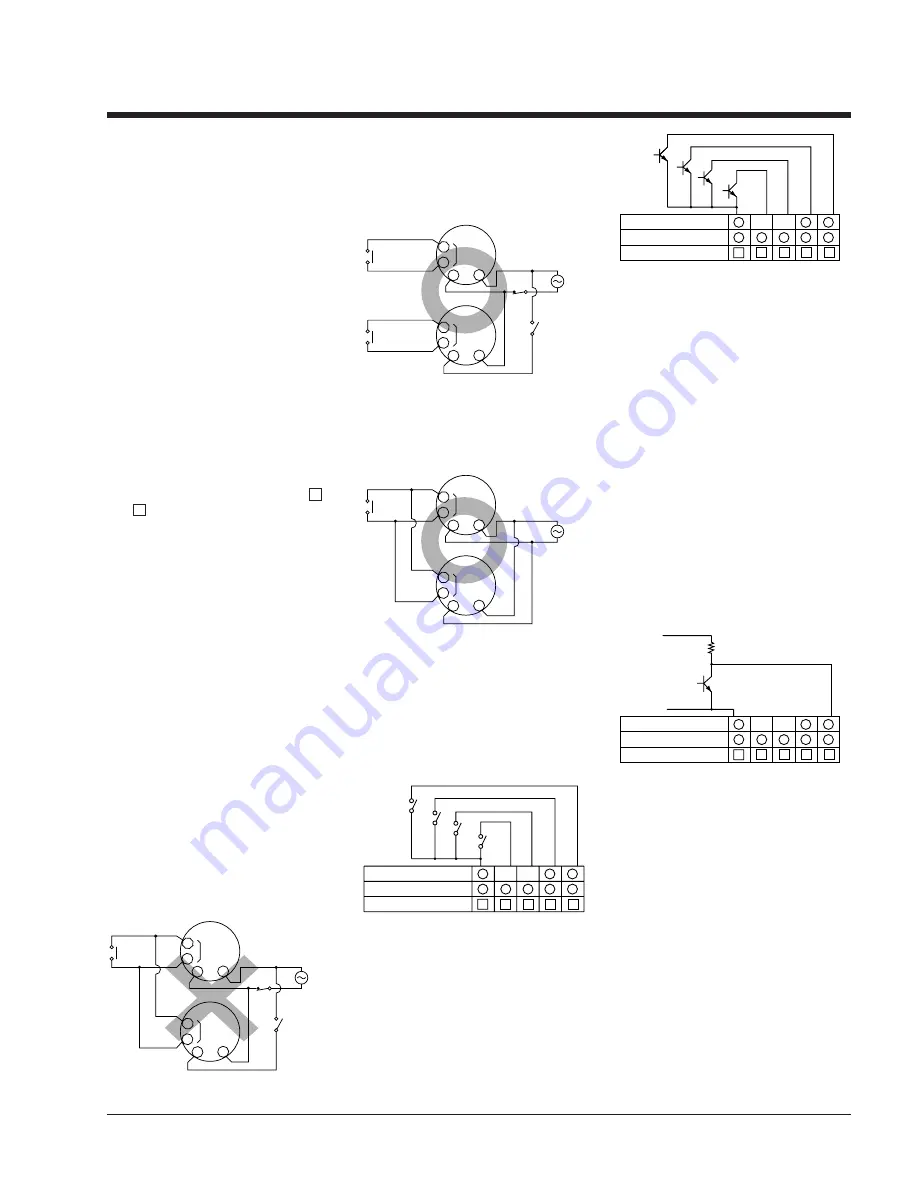
47
1. Terminal wiring
1) When wiring the terminals, refer to the
terminal layout and wiring diagrams and
be sure to perform the wiring properly
without errors.
2) When using the instrument with an
flush mounting, the screw-down terminal
type is recommended. For the pin type,
use either the rear terminal block
(AT78041) or the 8P cap (AD8-RC) for
the 8-pin type, and the rear terminal
block (AT78051) or the 11P cap (AT8-
DP11) for the 11-pin type. Avoid solder-
ing directly to the round pins on the unit.
When using the instrument with a front
panel installation, use the DIN rail termi-
nal block (AT8-DF8K) for the 8-pin type
and the DIN rail terminal block (AT8-
DF11K) for the 11-pin type.
3) After turning the unit off, make sure
that any resulting induced voltage or
residual voltage is not applied to power
supply terminals
W
through
U
(8-pin
type)
W
through
P
(11-pin type) or
and
(screw terminal type). (If the
power supply wire is wired parallel to the
high voltage wire or power wire, an
induced voltage may be generated
between the power supply terminals.)
4) Have the power supply voltage pass
through a switch or relay so that it is
applied at one time. If the power supply
is applied gradually, the counting may
malfunction regardless of the settings,
the power supply reset may not function,
or other such unpredictable occurrence
may result.
2. Input connections
The power circuit has no transformer
(power and input terminals are not insu-
lated). When an input signal is fed to two
or more timers at once, do not arrange
the power circuit in an independent way.
If the timer is powered on and off inde-
pendently as shown in Fig. A, the timer's
internal circuitry may get damaged.Be
careful never to allow such circuitry.
(Figs. A, B and C show the circuitry for
the 11-pin type.)
2
1
If independent power circuitry must be
used, keep the input contacts or transis-
tors separate from each other, as shown
in Fig. B.
When power circuitry is not independent,
one input signal can be fed to two or
more counters at once, as shown in Fig.
C.
3. Input and output
1) Signal input type
(1) Contact point input
Use highly reliable metal plated contacts.
Since the contact point’s bounce time
leads directly to error in the timer opera-
tions, use contacts with as short a
bounce time as possible. Also, select a
minimum input signal width of 20 ms.
(2) Non-contact point input
Connect with an open collector. Use
transistors whose characteristics satisfy
the criteria given below.
V
CEO
= 20 V min.
I
C
= 20 mA min.
I
CBO
= 6µA max.
Also, use transistors with a residual volt-
age of less than 2 V when the transistor
is on.
8-pin type
Screw terminal type
1
—
—
4
3
11-pin type
3
4
5
6
7
6
7
8
9
10
Reset input
Start input
Stop input
Lock
input
Reset input
12 to 40V DC
Q
(The above example is for reset input)
8-pin type
Screw terminal type
1
—
—
4
3
11-pin type
3
4
5
6
7
6
7
8
9
10
Reset input
Start input
Stop input
Lock
input
8-pin type
Screw terminal type
1
—
—
4
3
11-pin type
3
4
5
6
7
6
7
8
9
10
PRECAUTIONS IN USING THE LT4H SERIES
* The short-circuit impedance should be
less than 1 k
Ω
.
[When the impedance is 0
Ω
, the current
coming from the start input and stop
input terminals is approximately 12 mA,
and from the reset input and lock input
terminals is approximately 1.5 mA.]
Also, the open-circuit impedance should
be more than 100 k
Ω
.
* As shown in the diagram below, from a
non-contact point circuit (proximity
switches, photoelectric switches, etc.)
with a power supply voltage of between
12 and 40 V, the signal can be input
without using an open collector transis-
tor. In the case of the diagram below,
when the non-contact point transistor Q
switches from off to on (when the signal
voltage goes from high to low), the sig-
nal is input.
2) The input mode and output mode
change depending on the DIP switch set-
tings. Therefore, before making any con-
nections, be sure to confirm the opera-
tion mode and operation conditions cur-
rently set.
3) The LT4H series use power supply
without a transformer (power and input
terminals are not insulated). In connect-
ing various kinds of input signals, there-
fore, use a power transformer in which
the primary side is separated from the
ungrounded secondary side as shown in
Fig. A, for the power supply for a sensor
and other input devices so that short-cir-
cuiting can be prevented.
10
2
3
(Fig. A)
Input contact
point or transistor
2
3
10
Power
supply
Input
terminal
terminal
Input
10
2
3
3
2
10
(Fig. B)
Input contact
point or transistor
Power
supply
point or transistor
Input contact
terminal
Input
terminal
Input
(Fig. C)
Power
supply
3
3
Input contact
point or transistor
10
2
10
2
terminal
Input
terminal
Input


































